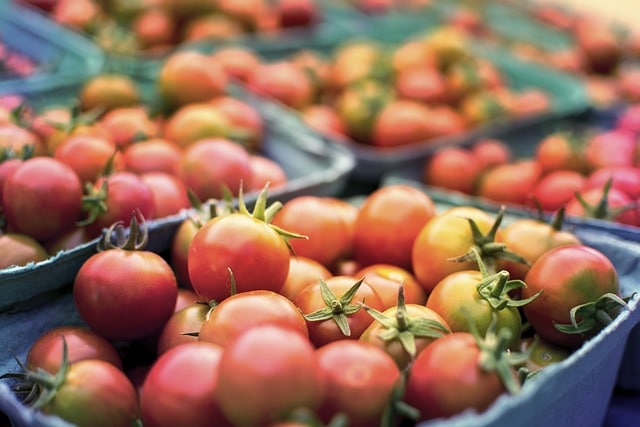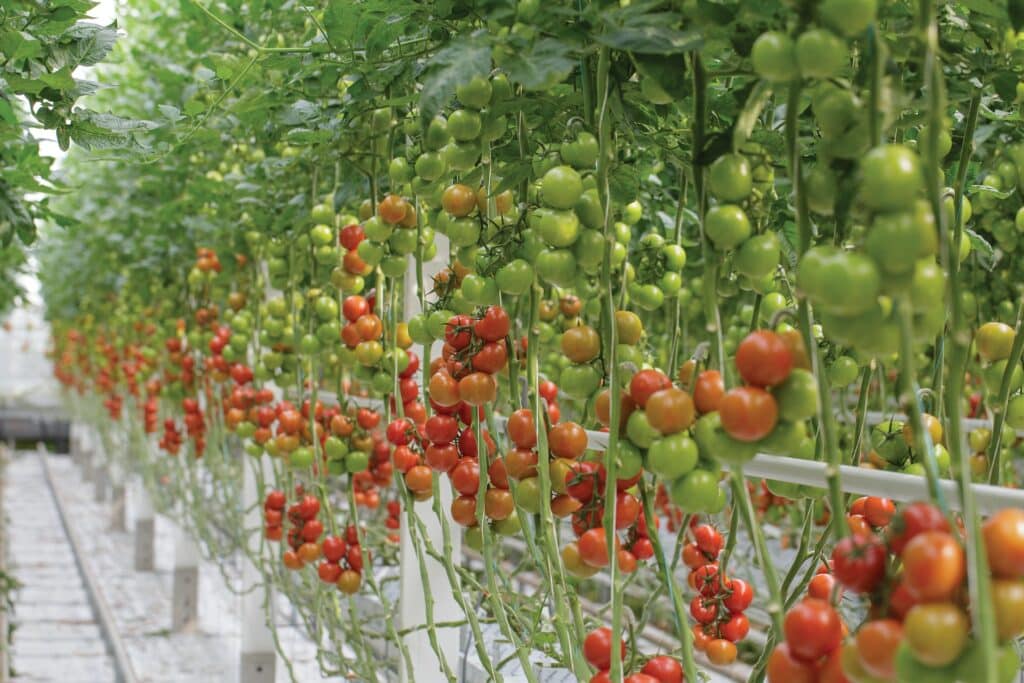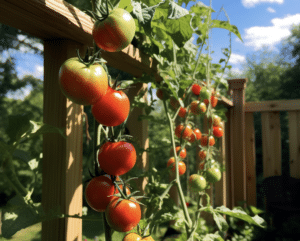Introduction – Tomato Plant Height
Always having a bountiful supply of delicious tomatoes can be tricky if your tomato plants get too tall. If you don’t get them to the right height, they won’t produce fruit.
So what to do when tomato plants get too tall? There are several different reasons why your tomato plants might grow too tall and not produce fruit.
Tomato plants can grow too tall due to insufficient light, over-fertilization, plant variety, lack of pruning or training, high temperatures, and crowded growing conditions. There are ways to fix the problem. In this article we’ll cover all six of these and more so you can grow healthy and happy tomatoes that produce lots and lots of fruit!

Proper Height Of Tomato Plants
First, make sure you’re planting in the right season. Go for a really sunny season and aim for fullness of fruit before frost. When you grow tomato plants, you want to make sure that they’re the right height.
The right height for tomato plants is 6-8 feet tall, as this gives them plenty of room to grow healthy fruit. If you let them get taller than 10 feet, they may take longer to produce fruit because they’ll have added weight and therefore won’t be able to bear their full crop as quickly as they could if they were shorter.
On the other hand, if you keep your tomato plants shorter than 6-8 feet tall then they won’t produce quite as much fruit either because there isn’t enough space for them all to reach maturity at once.
Tomato Plants Get Too Tall For 6 Reasons
- Insufficient light: If tomato plants don’t receive enough light, they will grow tall and spindly as they stretch to reach the light source. Ensure your plants receive at least 6-8 hours of direct sunlight or supplemental light if grown indoors.
- Over-fertilization: Excessive nitrogen in the soil can lead to rapid vegetative growth and tall, weak plants. To prevent this, use a balanced fertilizer and follow the package instructions carefully.
- Plant variety: Some tomato varieties are naturally taller than others. Indeterminate varieties can grow quite tall, whereas determinate varieties are usually more compact. Choose the appropriate variety for your gardening space and preferences.
- Incorrect pruning or training: Pruning and training your tomato plants can help control their height and encourage a more compact growth habit. Training a tomato plant refers to the process of guiding and controlling the plant’s growth to achieve a desired shape, size, and structure. Prune only non-productive branches and leave the main stems and fruiting branches.
- High temperatures: Tomato plants can grow taller than expected in response to high temperatures. This rapid growth can lead to weaker stems and reduced fruit production. Consider providing shade during the hottest part of the day to help regulate temperature. Tomatoes prefer daytime temperatures of about 70 to 85 degrees Fahrenheit, and nighttime temperatures between 60 and 70 degrees.
- Crowded conditions: If plants are grown too close together, they may compete for light and grow taller in an effort to reach the light source. Ensure that you provide enough space for each plant according to the variety’s requirements.
Addressing The 6 Problems Of Tomato Plants That Are Too Tall

Given that there are six reasons we gave above that cause tomatoes to get too tall, it stands to reason that for each one of them there is a way to fix the problem.
- What to do for insufficient Light: If your tomato plants aren’t getting enough light, consider moving them to a location where they will receive at least 6-8 hours of direct sunlight a day. If you’re growing tomatoes indoors, you might need to invest in supplemental lighting, such as grow lights. Adequate light exposure is crucial for proper growth and fruit production. Monitor your plants’ location and adjust as necessary to ensure they receive sufficient light.
- What to do for over-fertilization: If you’ve been over-fertilizing, you should cut back on fertilizer application. In future, use a balanced, slow-release fertilizer, and always follow the instructions on the packaging to avoid over-application and excess nitrogen which cause rapid growth and weak plants. Tomato plants need a good balance of nitrogen, phosphorous, and potassium. Using a fertilizer high in phosphorous can encourage more fruit production and less vegetative growth. Conduct a soil test to determine the nutrient levels in your soil and amend as needed based on the test results and recommendations for tomato plants.
- What to do for plant variety: If you have tall-growing varieties and this is causing problems, consider growing varieties that naturally have a more compact growth habit. You can also use cages, stakes, or trellises to support taller plants and manage their height. Indeterminate varieties tend to grow taller, while determinate varieties are generally more compact. Research the growth habits of different tomato varieties before planting to ensure they align with your gardening goals.
- What to do for incorrect pruning or training: Learn and apply proper pruning techniques. The idea is to remove only the suckers (small shoots that appear in the junction between two branches) that won’t bear fruit, or leaves that are shading fruit from the sun. Pruning should promote air circulation, reduce the risk of disease, and focus the plant’s energy on producing fruit. Training your plants will promote a healthier structure, improve airflow, and reduce the risk of disease.
- What to do for high temperatures: It might be difficult to control the weather, but you can take steps to protect your plants from heat stress. Mulch can help keep the soil cool and moist, and shade cloth can be used to protect plants during the hottest part of the day. Consider providing shade during the hottest part of the day to help regulate temperature and protect your plants from heat stress. You can also choose heat-tolerant tomato varieties if your growing area experiences consistently high temperatures.
- What to do for crowded conditions: If your plants are too close together, thin them out by carefully transplanting some to a new location. Tomatoes need ample space to grow properly, usually at least 2-3 feet apart for most varieties. Follow the recommended spacing guidelines for the specific tomato variety you are planting, and be mindful of the mature size of each plant. Proper spacing will promote healthier growth, improve airflow, and reduce the risk of diseases spreading between plants.
Strictly speaking you’re not trying to control the height of the tomato. You’re trying to get it into a healthy state so that it’s able to produce fruit.
Using A Trellis

When dealing with tomato plants that grow too tall, a trellis can be a gardener’s best friend. This simple yet effective support structure helps manage the height of the plants, keeping them off the ground and reducing the risk of soil-borne diseases. A well-placed trellis also improves air circulation around the plants and makes harvesting a breeze. For anyone struggling with towering tomato plants, incorporating a trellis into your garden setup can be a practical and efficient solution.
How To Grow Tall Tomato Plants
On the flip side are tomato plants that are too short! Tomatoes are one of the most popular vegetables to grow in the home garden, and they are relatively easy to care for.
One thing to keep in mind, however, is you will need to provide some type of support for the plant. This can be done by tying the plant to a stake or by planting it in a cage.
In terms of actually growing the plant, tomato plants prefer a sunny location with well-drained soil. They also need to be watered regularly, especially during the warmer months.
Once the plant has produced fruit, you will also need to fertilize it every few weeks to ensure that the fruit is of good quality.
Harvesting tomatoes is typically done when the fruit is fully ripe and has turned red. However, you can also pick them when they are still green and allow them to ripen off the vine.
Tracking Tomato Growth
Aside from height, it will be hard to gauge whether the plants are properly if you’re not experienced. Use our handy table below to help guide you.
| Week(s) | Growth Stage | Description |
|---|---|---|
| 0 | Planting Seeds | Tomato seeds are typically started indoors 6-8 weeks before the last expected spring frost date. |
| 1-2 | Germination | Seeds germinate, usually within 7-14 days. The first pair of leaves, called the cotyledons, appear. |
| 2-6 | Seedling Growth | True leaves form. Seedlings should be given plenty of light and kept at a steady temperature. |
| 6-8 | Hardening Off | Gradually introduce the plants to outdoor conditions to prepare them for transplanting. |
| 8 | Transplanting | Transplant seedlings outdoors after the last frost date when soil temperature is consistently at least 60°F. |
| 8-12 | Establishment | Plants begin to grow taller and develop more foliage. Water regularly and apply a balanced fertilizer. |
| 13-16 | Flowering | The first flowers begin to appear. This is when the plant begins to set fruit. |
| 16-20 | Fruit Development | The first green tomatoes form and start to grow. |
| 20+ | Fruit Ripening | The first tomatoes start to ripen. This typically happens about 20-30 days after fruit set, but can vary widely depending on the variety. |
| Continuing through Frost | Ongoing Harvesting | For indeterminate varieties, flowering, fruit development, and ripening continues until frost kills the plants. During this time, continue watering and feeding the plants, and harvest ripe tomatoes regularly to encourage more fruit production. |
Conclusion
If you are wondering what to do when your tomato plants get too tall, don’t worry. There are many ways that you can fix this problem. You just need to be aware of how tall tomato plants grow, how they can become too tall, and how you can fix this issue.
